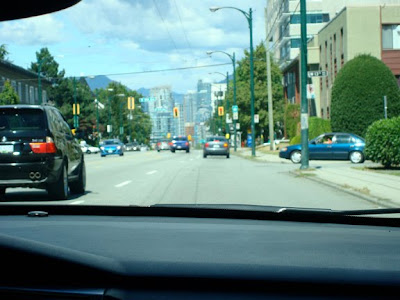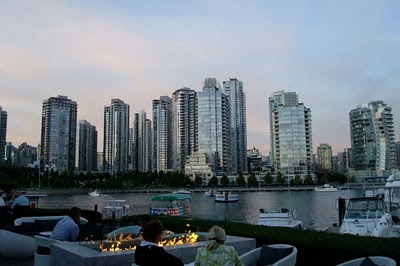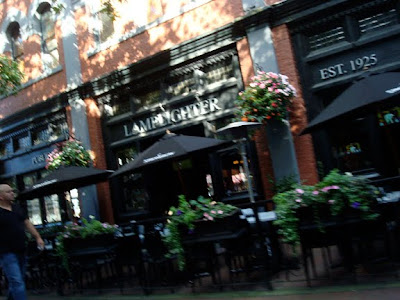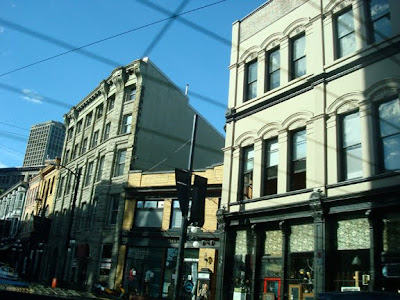
(dozens of photos to follow if you can follow along…)
Recently, I had the chance to visit Vancouver for the first time in my life without the digital aid of google earth. I was visiting friends in Seattle, a city I have been to about a dozen times for bidness (sic), but selfishly I finagled a group day trip up to Vancouver. In GE, I’ve probably been there 1000x time, but you never know a place until you can actually see how people interact with the place. GE is good for elucidating long-term processes and dynamics of cities, where people live, where investment is happening (or happened, and when), where successful (or failing) shopping districts/corridors are, etc.
This is one necessary way of seeing a city, but the other is very much in the William Whyte/Jane Jacobs school of observation and empiricism, profoundly scientific at its core. This is also why there is more to learn about cities and urban design through those two, as well as the physical, social, and computer sciences. Each at their heart, some measure of physics at work in their networking dynamics.
This is also why you might as well throw anything architects say about a city out the window. Typically too engaged in window dressing or theoretical and rhetorical gymnastics to “litter the world” with their selfish aesthetic purview. This is a bit harsh and painting with a broad brush myself, but also why so many starchitects make zero sense when you really analyze their words closely. They’ve made a profession of talking wealthy clients into a dizzying trance. “Wow, I have no idea what you just said, you must be smart.”
What does this have to do with Vancouver? Well, it is a city where historic urban fabric and modernism collide, but skillfully and often subtly. Occasionally the contrast of hyper modern and historic can be striking, but struck too often, and your senses are dulled into a vegetative state of a teenager overwhelmed by “flashes” or “jolts” watching MTV. Literally, there are studies about how many “jolts” (a sudden bright image or loud sound) a human can take per second or minute. MTV began this and many other television networks followed suit. They literally and often intentionally turned us into couch potatoes. Tune in, zone out, absorb advertising comin’ atcha!
The (rhetorical) question is what demands more out of the user? That which makes our brain tune out or is easily accepted, or that which requires some work on our part, to decipher and interpret. I choose that latter and frankly, if we accept that cities are an exercise in social engineering to some extent, a certain amount of paternalism is necessary. Recall the quote from so many people now that it’s lost its attribution that, “we shape our cities and therefore they shape us.” Do we expect more out of our audience or less. Do we expect more out of our citizens in daily life? Or school kids just let out of class and back into the city? Or do we just assume they’ll wreak havoc. Expectations. People live up (or down) to them.
I believe the most genius is to be found in subtlety. Anybody can ram two tonka trucks together and make them crash, but how many people can split an atom? In many ways, this is what Vancouver has successfully done. Nearly every inch of the city has been spoken for, designed. Perhaps, not by real designers, but like any highly lived in and cared for place, it has been molded by the users. Enough users, enough decision makers, the more place changers. The more people, the more pressure is exerted on that city. Are they there by choice or forced to be there?
This ends up being a key factor in successful cities/places and their livability. How many people are there above those that have to be there. Many people say Dallas is importing people because there are jobs here and not jobs in other parts of the country. Those classify as people who are here by need, not desire. Those needs eventually evaporate and can’t be counted on forever. People go to (or stay in) Vancouver because they want to be there to a much greater increment than Dallas, I would surmise. Furthermore, we can look at this from a city vs. suburb scale or even micro: one public space vs. another, even within the same neighborhood. Why does one work and not the other? All of the elements in the equation have to be spliced apart to understand the reasoning properly if never quite fully.
I don’t want this to be a “OMG Vancouver super awesome brah, up top!” type of post. I also don’t want it to be overly affected by the absurdly nice weather we happened upon in the PacNW. If it were 75 and sunny everyday, would anybody live anywhere else? I dunno. It is why you’ll see me working from outside almost every day here in Dallas this fall. /Dallas weather sucks! Nobody wants to be outside. Ok. Thanks for the tweet Ms. Postrel.
Side note: I’m amazed how nice Seattle weather has been every time I’ve been up there. If I didn’t know better, I would think there was some Greenland/Iceland Viking 3-card monte going on.
I found there to be two Vancouvers. The Vancouver that you see from afar (take that literally or metaphorically) and the Vancouver experienced on the street. The latter is by far the more intricate, complete, and complex. And that very well might be the best possible outcome for the two disparate vantage points. From afar, you’re looking for beauty, coherence. In person, challenging and stimulating activity, the kind of density of activity and connectivity that creates gravitation, places people want to be just to be. Remember, we like to watch people (also why you’ll find most people in any space clustering around the edges).
This post is going to focus on the why and the how for that phenomenon, why Vancouver is so heralded these days, and why it generated the kind of buzz that buys Olympic bids (not literally, ahem SLC and ATL /sideways eyes).
I’ve mentioned these points in various previous posts, but it is always worth restating. Vancouver has a few main things going for it:
- Dramatic yet constrictive geography – almost an equivalent of urban growth boundaries, except to the South where there is ample, flat, arable land.
- ’90s Asian investment seeking financial security and potential growth during lost domestic decade
- ’60s era decision by Vancouver policymakers not to allow highways into the city…and diligence/perseverence sticking to it
The last has probably been the most important and influential over the long-term in spite of what I presume were some naysayers calling the decisions “backwards.” In reality, it was probably a defensive maneuver or perhaps a calculated risk, but one that has paid large dividends.
Much like Copenhagen, the process in creating cities hailed today as some of the most livable in the world began in the 60s. Copenhagen removed cars from streets incrementally, Portland under a republican state governor established urban growth boundaries to preserve agricultural and natural land, Vancouver decided freeways were antithetical to what cities are about, neighborhood livability, commercial vitality, and interconnectivity.
The common argument for highways is that they improve connectivity and trade, because of fast moving traffic, but do they? Well, we know that answer. On a regional scale they do, linking regional economies, say in this case Seattle-Vancouver (with that one big barrier in between), but they cause more harm to connectivity on the neighborhood and city scale, the local economy.
CEOs for Cities recently issued a scathing critique of the Texas Transportation Institute’s basic formulae. The report entitled Driven Apart shows the limitations if not instilled biases towards increased highway construction. The mobility index is all about speed rather than distance. If I’m driving fast, traffic is clear, things are moving, all is well. Except, 1) that doesn’t take into account negative effects, and 2) if it is based solely on velocity rather than a)mode b)efficiency c)pollution d)real estate effects or e)proximity, it is immediately biased towards providing more and more highway travel lanes. Taxpayer, you’re on the hook, indefinitely, cuz those things don’t maintain themselves.
The natural response is that traffic must be hell, particularly entering the city. There were three traffic backups delaying what should have been little more than a two-hour drive, none of which were directly related to the scaling down of streets (because capacity is added by the grid, the entirety of the system). The first was the border crossing. The second, was through a tunnel which inexplicably was closed down to one lane. And the third was for construction of townhomes along the arterial once into the city, yes, right along what otherwise would have been a highway. Smaller road = more private investment, better balance between taxbase and infrastructure.
The reality is that it isn’t bad if the people don’t follow the parasitic straw of highways outward as well. They remain close in to the city where all other forms of transportation are viable if not preferable for some percentage of trips. We’ll look at why later.
Here is a sequence of the “highway” approach to Vancouver:

Entering the residential periphery the highway steps down in classification to a six-lane signalized arterial. Highway speeds are incompatible with the neighborhoods, but it maintains capacity (if not increases it as cars slow and distances between narrow). The grid then allows for pressure release and increasing choice of route as you enter more density (of destinations).
sidenote: You could say, well why not just build a highway bypass? But, why would you want people to bypass your city? More of a philosophical debate there than a pragmatic one, but a question that should be asked.

Now, in a more robust grid (more optional routes), we are down to four total lanes. Furthermore, part of the denser grid, is shorter blocks, and more intersections which further slows traffic, becoming more compatible with more and more people, i.e. residential density.

And next thing you know, you’re crossing bridges into the city, which looks almost exactly as you imagine it, populated by 20-story blue-gray glass towers.
————————————-
Stepping back to the TTI formula/CEOsForCities critique for a second, if I walk across the street to the store, I am moving more slowly than somebody who drives to the nearest Kroger or wherever, but which is actually more expedient, more efficient (energy or otherwise), or more enjoyable?
None of these questions are asked by TTI, but they are precisely the ones that must be asked within cities, which have an infinite array of factors that must be considered. TTI would do so, except that might dry up the highway trust fund and their personal crusade (for whatever ends) is over. Some of those questions are rhetorical, others are subjective, which is exactly what makes for livable cities, choice and the full and at least equal ramifications for individuals to decide.
TTI, whose data is essentially the be all and end all for all transportation choices, is absurdly flawed. Without competing metrics and proper application of values, the decision is always, “huh, I say I say I say, guess we need mo’ highways.”
What the highways do in practice to residential real estate markets is move the tipping point between cheaper land (an amenity) and the amenity of proximity: to goods, services, jobs, etc. When you live closer, you don’t have to drive 60 miles per hour to get everywhere, and the resultant urban form is at a slower, more humanly acceptable pace, yet better connected, and frankly faster and more cost efficient for both user (less transportation cost) and city (less infrastructure cost – which is translated into taxes).
When land, fuel, and commuting time costs are so low, it is almost insane not to buy a big ol’ house at the edge. Everybody heads out there. It happened in Dallas. Tax base headed north. It stuck around in Vancouver because there was more advantage (and presumably long-term return on investment) to stay close even if it meant a smaller home or less square-footage per person.
There is another emerging facet of this equation, the down-sizing movement around the country with regards to house size, moving back into what some might consider more cramped quarters, closer to the city, not for reasons often mentioned, but with the explicit intention to become closer as a family. Rather than Sally texting, tweeting, facebooking, and chatting up in the fourth bedroom, roughly three miles from the “living room” where Mom and Dad are huddled around the suburban campfire, the television, the family is forced into constant interaction. While we may occasionally hate family, the socialization, forces us to become more, ahem, socialized, more tolerant of others and less withdrawn from anyone other than ourselves.
This is the same concept with design, the more interaction, the greater decisions per amount of time occur, applying an upward design or usability pressure to a(ny) place.
I see this locally in downtown Dallas, where new residents are looking to get out from within their cocoon. Their loft is their bedroom, but their living room is the city, out with others. We are social creatures. Uptown is still mostly graduated suburbanites yet unready to find themselves, instead more comfortable letting their dogs greet strangers through the funniest way imaginable, butt-sniffing.
But enough tangent tripping and back to the photos…

The first area we entered was in and around a neighborhood known as Yaletown, which was wonderfully low-scaled and intimate for the most part; the kind of place that looked like they’ve been lived in and occupied for years, adapted for and by the citizens.

A locally adapted detail here. There is a clear plexiglass panel within this awning. It does two things, allows more light because of the all the gray, dreary days and covers the outdoor eating/sitting area from the rain. How many things do we have here that are designed specifically for Dallas? Or Texas? Many seem as though they could be anywhere in the world.
Now, to planner porn. When former city planning director Larry Beasley was in Dallas last, he seemed to want to get away from what Vancouver is best known for in architecture and planning circles, the point-tower. What this means is a podium base that never gets much taller than four or so stories, with a tower rising from the middle of this base.
The intention is that from the street, the pedestrian never feels overwhelmed by the scale and height of the building. Other unintended consequences of tall buildings include wind shear (creating extreme wind gusts below) and a privatization of the sun to some extent, creating an overly shaded street. In cities where the sun is rare, it is critical to prevent this from occurring. In Dallas, we just make every building reflective glass to amplify ambient temperatures ten or fifteen degrees at the street. Smart. (But, we’re being super green dude!)
What Vancouver did, was essentially establish invisible volumes that when investment arrived at various blocks it would fill up the “glass” as construction of buildings deemed suitable and complementary to the street and adjacent blocks. My guess is that this solution was a compromise. Because there were no highways into the city, there was no sociofugal force that scattered and gutted the city that had incrementally formed and clustered over decades and centuries.
Because nobody had left, there was no incentive to pave and park. The citizens were happy with their city the way it was, and to accommodate this new asian investment (who wouldn’t turn down that kind of money?!). The City HAD to find an acceptable compromise between (Far) East and (Pacific North-)West, between investment demanding increased density, and all of the historic fabric.
Here is a series of those:

Two-story base. Notice the rooftop garden spilling over.

The same building. It has some art deco things going on to it. I can’t tell if it is new or old, which tells me it either is aging or will age well.

Here is another base of a tower, a series of townhomes and stoops lining the quieter side street. The is density interfacing with public space with extreme delicacy.
On the surface, Vancouver is all about those shimmering, elegant glass towers. The life of the city is still at the street, just as Jan Gehl suggested when he blamed too many cities and architects focusing on skylines rather than sidewalks. Vancouver tried to bridge the gap between the two, and while they did so to accommodate density, there is still more density in dreadfully un-urban Las Vegas.
While I got the impression that many of these towers were little more than arm candy, staring back blankly and dumb, perhaps that is the only way to make building height work with the ground plane. The towers are meant to be seen from afar, the ground plane is meant to be interacted with, touched, felt, and interfaced. It was necessarily more human. In Dallas, we plop down a porte cochere and valet stand. But interface is partially the fault of road design.
This is why you can’t get into the density debate. Much of Las Vegas is more dense than Vancouver, far more people live in the intricate, tightly knit surrounding neighborhoods in Vancouver than the glass towers, which are filled like many other recent condo towers, with speculators and second-, third-, or fourth-home buyers. Rather, we must maintain urbanism as an issue of design. Not design as most see it, the superficial and subjective, but rather the objective: design function and relationships between buildings, streets, and spaces.

You’ll notice sometimes I tilt the camera to get more into the frame, usually the horizon.

I have no idea what kind of building this is. It was across from the convention center (which isn’t the beached whale the same facility is here).

Every side street, turns the corner and immediately changes character from hustling/bustling to residential scale/proportion. Notice the baby carriage. Downtown Vancouver actually has a dearth of schools (and space to put them). So many young families moved downtown in the past 15 or so years, that they have not been able to keep up.
Of course, everybody will tell you only young singles and empty nesters will live downtown. They are full of shit. New York City is having the same problem in lower Manhattan. Once again it is about desirability and safety, aka design.
Granville Island:

See the entry bridge into the city from earlier in the post. Same one. Interesting here, because it is so high that it doesn’t have the negative effect many bridges, viaducts, and highways have on the desirability of the ground plane. New TxDOT campaign: Raise all the freeways! Just kidding. Or we could go all Le Corbusier and put them on top of buildings.

Kid spray park on Granville. Amazing how many amenities for all ages are in an around the downtown area. These are chicken/egg. You can build them for nobody in hopes they come, but it is better, easier, and cheaper to respond to rising demand for amenity, by getting people to live downtown by other means, ie transportation advantages, not having highways to the burbs.
And this wouldn’t be complete without a trip to the Olympic Village, which was remarkably similar to Victory in Dallas in many ways, not the least of which because they’re more like ghost towns than development prototypes. I think I’ll turn the rest of the Olympic Village analysis into a post of its own because it deserves it, especially after Kaid Benfield tweeted at me that it represents the new model of sustainable development. Hint: I’ll disagree. The City still owes a billion in cash money on this piece, hardly sustainable. For now, enjoy the design detail, because frankly, it is pretty exquisite…
Also, I edited Seattle out of this one to make into its own post as well.









































